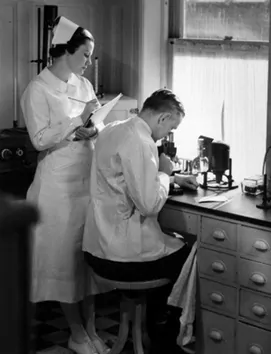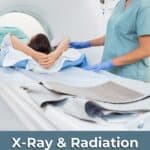If you work with or around X-rays, you need these radiation safety tips for nurses. X-ray safety is an important concern when working in the radiology department or transporting patients to this area. Orthopedic nurses, for example, often have patients who need X-rays. Even med-surg nurses have patients with bedside X-rays to confirm NG tube placement, chest tube placement, and the location of the end of a newly placed PICC line. In this article, we’ll share the impact of X-rays on your body and help you stay informed with essential X-ray safety tips.
Table of Contents
X-Ray & Radiation Safety for Nurses
Have you ever thought about how much worse long-term exposure to X-rays could be? Generally, the safety precautions we have in place are for patients who just visit X-ray wards once or twice a year or only in emergency situations. But what about the staff performing their duties in X-ray wards? If you’re a nurse who is regularly exposed to X-rays then you must know its hazards, and follow the safety measures in order to minimize the detrimental effects of radiation.
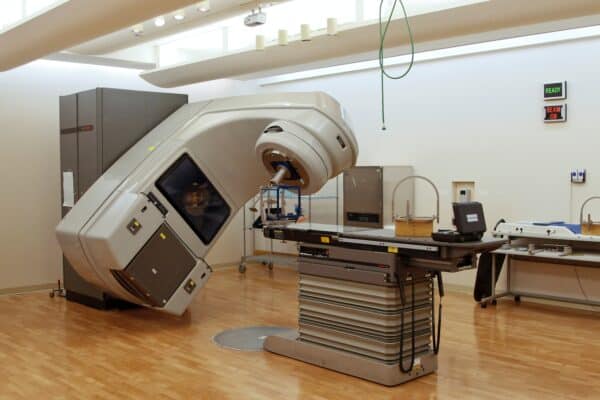
Effects of X-rays on Different Parts of the Body
Radiology department nurses, performing frequent diagnostic imaging through fluoroscopy, MRI, or CT scans, are at risk of cumulative radiation exposure over time. When the primary X-ray beam interacts with the patient’s body and scatters in different directions, it is absorbed by the body. Even though nurses are not the primary subjects of X-ray procedures, continuous exposure to ‘scatter radiation’ without adequate protection can pose radiation-related health issues.
X-rays can have varying effects on different parts of the body depending on factors like the radiation dose, duration of exposure, and the sensitivity of tissues.
Skin
Prolonged or high-dose exposure to X-rays can cause radiation burns on the skin, similar to thermal burns. These burns may be painful and can damage the skin’s integrity.
Eyes
The lens of the eye is particularly sensitive to ionizing radiation. Chronic exposure to X-rays can increase the risk of developing cataracts, which can lead to vision impairment.
Thyroid Gland
The thyroid gland is sensitive to radiation, especially in the neck and head region. Exposure to X-rays can increase the risk of thyroid cancer or thyroid disorders.
Bones
X-rays penetrate the bones, so excessive or continuous exposure can increase the risk of developing radiation-induced bone cancers.
Reproductive Organs
While working in a radiation zone, exposure to the reproductive organs can lead to temporary or permanent infertility. Pregnant nurses are particularly sensitive to radiation, as it can harm the developing fetus and increase the risk of birth defects.
Blood Cells
High doses or continuous absorption of radiation can damage the bone marrow, where blood cells are produced. This can lead to a decrease in white blood cells, red blood cells, and platelets, increasing the risk of infection, anemia, and bleeding disorders.
X-rays pose potential health risks due to its ability to damage living tissues and increase the risk of cancer and other health problems. Therefore, the exposure to X-rays in hospitals and laboratory settings must be regulated to ensure safety.
X-ray Safety Tips for Nurses
Now that you know how radiation can affect different parts of the body, here are some things that you can do to minimize their hazardous effect and keep your health intact.
1. Wear X-ray Safety Goggles to Protect Your Eyes
The X-ray safety goggles are an indispensable tool for nurses while working in a radiation zone. They offer robust protection for the eyes against the hazards of indirect X-ray exposure. With lead lining, durable materials, and a comfortable design, these goggles provide a critical barrier between your eyes and radiation, ensuring your long-term eye health.
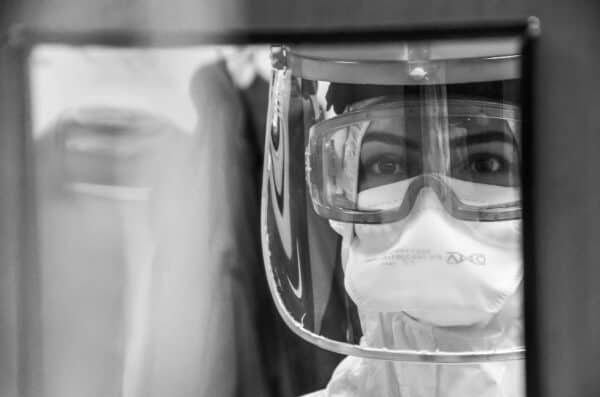
X-ray safety goggles work through a combination of key features:
Lead Lining
Radiology safety goggles are typically lined with a layer of lead or lead-equivalent material. Lead is highly effective at attenuating ionizing radiation, meaning it absorbs and reduces the intensity of X-rays.
Wraparound Design
Most of the safety goggles have a wraparound design that offers a snug fit around the eyes, thereby minimizing the potential for radiation leakage from the sides.
Protective Lenses
The lenses of these goggles are made from high-quality materials that can effectively block X-ray radiation. They are designed to be durable, shatter-resistant, and distortion-free to ensure clear vision.
2. Wear Lead Aprons to Protect Vulnerable Areas
Lead aprons, also known as radiological aprons or X-ray aprons, are specially designed garments crafted from a lead-infused material. Lead is exceptionally efficient at absorbing x-rays, so the primary function of a lead apron is to reduce the intensity and bodily absorption of X-rays. They offer protection to specific areas of the body, including the thyroid, chest, and reproductive organs. The apron’s lead lining is concentrated in these critical regions, ensuring that the most vulnerable areas are shielded from harm. This targeted protection minimizes the risk of radiation-related health issues.
These aprons are available in various sizes and styles to accommodate different body shapes and preferences. So if you are a nurse with prolonged exposure to X-rays, you should wear a flexible and comfortable lead apron that provides a robust shield to scatter radiation.
3. Wear a Thyroid Shield
One of the most effective measures is to wear a thyroid shield, or collar made of leaded material. These shields are specifically designed to protect the thyroid gland from scattered radiation. They should be worn snugly around the neck and cover the thyroid area completely.
4. Wear a TLD Badge to Measure Absorbed X-ray Dose
A TLD badge is basically a radiation monitoring device. Nurses should wear a TLD badge to measure their exposure to X-rays. It is important to note that, if you are wearing a lead apron then you must wear it inside the lead apron.
How Does a TLD Badge Work?
A TLD badge contains small, crystalline material that is sensitive to X-rays. When the badge is exposed to X-rays, it absorbs energy. This absorbed energy is then stored in the crystalline material. After that, the badge is collected for analysis (to measure the absorbed X-ray dose). The trapped energy is released by heating the crystals (thermoluminescence) and this process emits a visible light. The amount of light emitted is directly proportional to the amount of radiation to which the TLD badge was exposed. In this way, the absorbed X-ray dose for nurses working in radiology departments is calculated.
So wearing TLD badges while working in radiation-prone environments can ensure that you do not exceed allowable radiation dose limits.
5. Mobile Proactive Barriers to ensure radiation safety for nurses
Using mobile proactive barriers in the radiology department offers nurses an effective way to mitigate the hazards of indirect X-ray exposure, safeguarding their long-term health. These barriers offer a dual advantage: they provide a protective shield against scatter radiation and afford nurses the flexibility to maintain efficient workflow. This practical approach not only ensures their personal safety but also enhances their ability to deliver quality patient care with confidence.
You can buy mobile proactive barriers here.
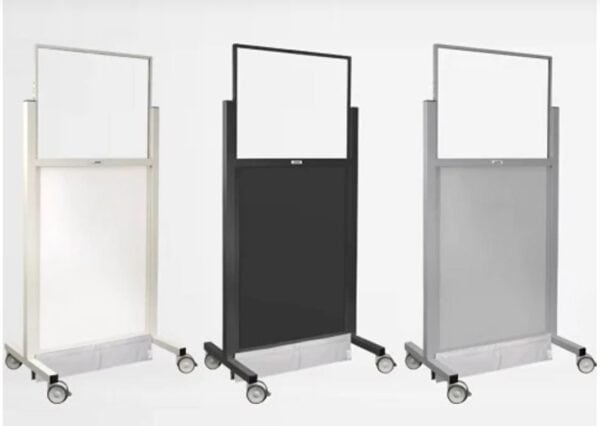
6. Consider Involving Caregivers as a One-Time Support
The safety of a nurse is as important as that of the patient. Although nurses are trained to minimize radiation exposure and wear protective gear, it’s crucial to recognize that the relatives or parents of the patients can provide invaluable support during these moments.
To reduce the cumulative radiation exposure that healthcare providers might face when assisting with X-rays, involving family members or caregivers as a one-time support can be a practical solution.
This approach ensures that the healthcare professionals themselves, who work diligently each day to care for patients, are exposed to X-rays only when absolutely necessary. By encouraging patient relatives to step in during these brief but crucial moments, we can minimize radiation exposure for healthcare providers and maintain a safer working environment for all involved. It’s a small but significant step toward ensuring the long-term health and safety of nurses working in radiology departments.
Bottom line
In the dynamic world of healthcare, where patient well-being is paramount, ensuring the well-being of nurses is equally crucial. Being a nurse working in a radiation zone, you should never have to compromise on your safety. The risks associated with radiation exposure should be carefully managed through the above mentioned safety measures, protective equipment, and adherence to established guidelines to minimize these hazards.

Do you have any X-ray or radiation safety precautions your hospital adheres to for your staff? Share in the comments below!
And if you enjoyed this post about X-ray safety tips, you might also enjoy these other articles on nurse safety:
- How To Disinfect Scrubs
- Science Classroom Safety Tips
- The Role of Technology in Improving Working Conditions for Nurses




